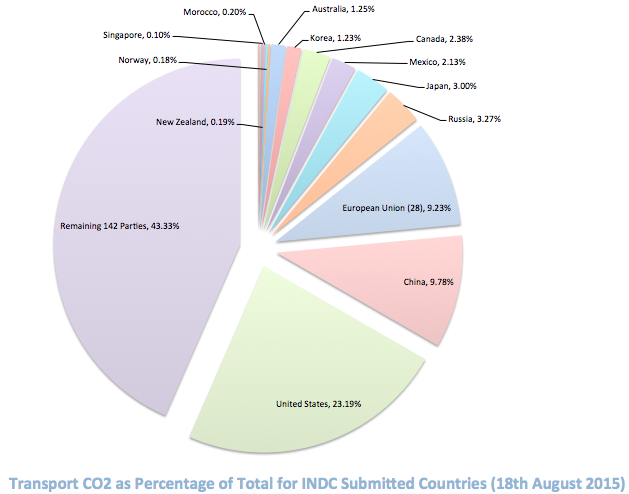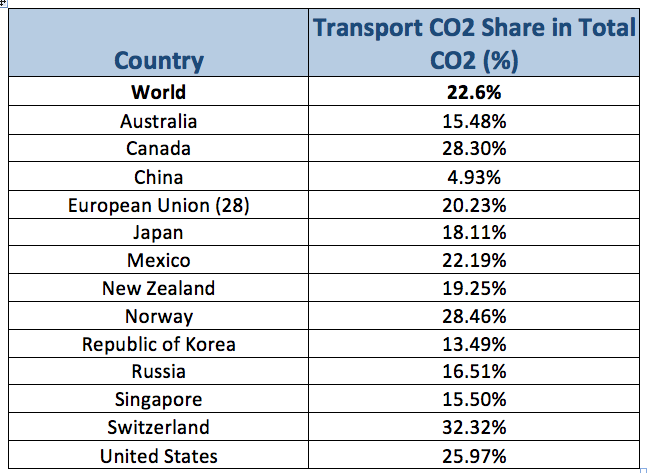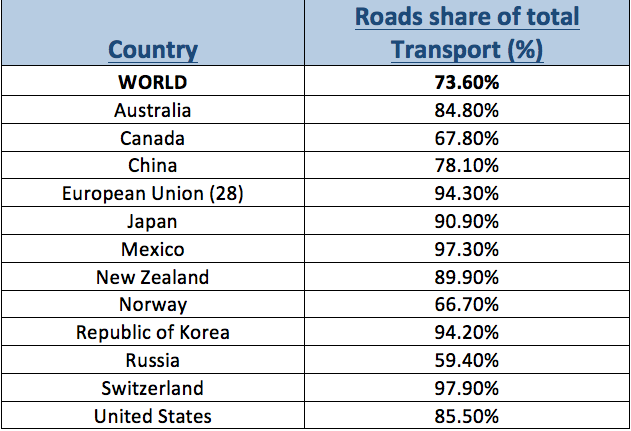57% of Global Transport Emissions covered by Current INDC's
A transport-focused summary of currently submitted Intended Nationally Determined Contributions (INDC)- 18th of August 2015.
Djibouti, the latest party member to submit its INDC, brings the total tally to 27 country submissions. With these 27 submissions, 54 parties (countries) are represented, with Latvia making the submission for the 28 member states (parties) of the European Union (EU) as a single submission. INDCs are national communications to the United Nations Framework Convention on Climate Change (UNFCCC) which detail the contributions of the submitting country intends to commit to reducing Greenhouse Gas (GHG) emissions.
By July, there were 21 submissions when a report by FactorCO2 was published; it stated that the countries that had submitted INDCs covered less than 59% of global GHG emissions; this is now closer to 60% with the current 27 submissions. Of the total global transport emissions, 57% are covered by the current contributions of the 54 parties, as can be seen in the pie chart below (only showing major emitters). The US makes up 23% of total global transport emissions while the EU and China make up nearly 10% each; together they make nearly half of the world’s transport emissions.
 Data source:CO2 Emissions from Fuel Combustion, IEA, 2014
Data source:CO2 Emissions from Fuel Combustion, IEA, 2014
The transport sector makes up a large part of GHG emissions in the 54 parties represented, some with transport emissions being the number 1 emitter in their country (such as Canada). In other cases such as Australia, emissions from its transport sector are second to electricity generation but still a heavy emitter. A list of selected INDC countries’ transport sector emissions as a percentage of total country emissions can be seen in the following table:

Table 1: Transport CO2 as a share of total country CO2 emissions (selected INDC submitted countries)
Furthermore, road transport emissions usually make up a large part of total transport emissions in just about all countries, exemplary in table 2 below for selected INDC countries. Interestingly, small countries that border large countries on all sides can be nearly as high as 100%, Luxembourg, for example, has 99.8% road transport share. This shows the dependence on roads for passengers and freight which can be quite CO2 intensive.

Table 2: Roads share of total transport emissions (selected INDC submitted countries)
Of the 27 submissions as of 18th of August 2015, most countries have expressed improvements in their transport sector and that the sector will be a part of their mitigation efforts in reducing emissions. Benin, for example, states that ‘improvements in urban infrastructure’ is part of reaching their mitigation target of 120 Mt below BAU (Business As Usual) by 2030. 22% of the others go the step further to describe specific transport sector targets, like:
- Trinidad and Tobago state that they will “reduce public transport emissions by 30% by 2030;”
- Ethiopia, which intends to reduce transport emissions by 10 Mt by 2030, states that this is part of their national plan to reduce by 230 Mt to 2030, which is 64% below their Business As Usual (BAU) scenario;
- Japan, which intends to reduce transport sector emissions by 27% below 2013 levels to 2030, states that this is part of their intention to reduce country-wide emissions by 26% below 2013 levels by 2030.
To keep up to date with these submissions and contributions, SLoCaT has created an on-going Database of current INDCs focusing on the transport sector. This matrix presents a summary covering the current contributions to date, a detailed look at their transport relevance and an overview of resultant GHG mitigation efforts. The database will be updated constantly while we report periodically in the lead up to COP21 in Paris in December this year. With SLoCaT’s database showing 27 submissions to date and 54 parties represented, that leaves 142 parties still to submit. With Paris and COP21 just 4 months away, we hope to achieve a high level of data in our transport relevant database and report regularly on the transport relevance of all contributions.
On a side note, a recent SLoCaT transport focused review of a special report by the International Energy Agency (IEA) on different mitigation scenarios in the near future states that ‘implementing current INDC pledges will not be sufficient to limit the rise in temperature below 2°C. If energy sector carbon mitigation efforts are not enhanced after 2030, the emissions path established by the INDC Scenario would be consistent with an average temperature increase of around 2.6 °C by 2100 and 3.5 °C after 2200′. The report focused on pledges up to May 14, 2015 but with likely contributions from major economies from China and India. Since May, we have had some promising pledges and with 142 more parties to submit before October 1st, a sense of optimism instils.
It is clear that the current INDC pledges addressing transport are from countries that recognize transport sector as a heavy emitting sector and there is an urgency to address this issue. Countries that do not set specific targets for the transport sector will fall short of the mark to carry out effective mitigation action to tackle climate change. SLoCaT’s database and the Paris Process on Mobiltiy and Climate (PPMC) will help decision-makers and interested persons understand the role of transport in GHG emission reductions and on how countries are tackling it.
-For SLoCaT’s review of the IEA special report, please visit this SloCaT webpage
-For a list of INDCs submitted to date, please see this UNFCC webpage. For SLoCaT’s current transport focused INDC database, please see the following SLoCaT webpage.